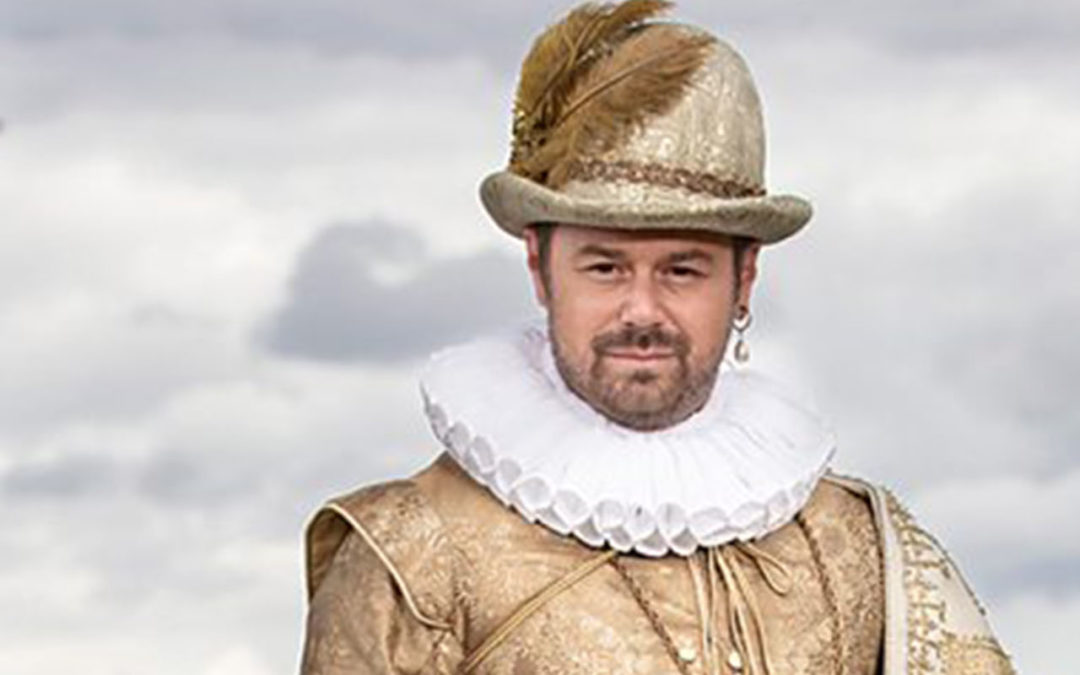By Paul Dryburgh
There are times, particularly in our social media age, when professional historians can be more than a little po-faced and self-important when it comes to the communication of history to mass audiences. There, I said it.
Enter, though, an unlikely herald – Danny Dyer, Eastenders actor, notorious Brit-flick hardman and geezer of all geezers, a modern-day everyman. Derided early in his career as ‘the byword for low-budget, no-quality Brit-trash cinema’, his role as landlord of the Queen Vic and the recent discovery of royal roots in a well-received episode of hit genealogy series Who Do You Think You Are? have, it seems, transformed his career and status as wannabe national treasure. With it all going cako bako, he claimed last October that his new two-part, primetime BBC1 series Danny Dyer’s Right Royal Family, which began last Wednesday, would, bear with me here, ‘inject fun’ into history, an assertion at which even the late, great, Sir Roger Moore would have raised more than one eyebrow, let alone the entire historical firmament.
It turns out that Danny ain’t gonna let us down. Oh no! In a fresh, effective approach to TV history aimed at the ordinary geezer (if not necessarily gal), the producers, Wall to Wall, should be congratulated for infusing fun with fact and embracing – often literally – the expert opinion of some of Europe’s finest medieval historians, art historians and archaeologists. Yes, this is history with its tongue firmly in its cheek. But it is history, nonetheless, and leads Danny – with the viewer – to some essential truths about the medieval period through a combination of practical demonstrations and tête-a-têtes with his experts.
The central conceit is the revelation that Danny is not just directly descended from Edward III, his 22-times great grandfather, but from some of the greatest figures in medieval European history. On his ‘nutty journey’ he meets the anxious Rollo Ragnvaldsson, Viking duke of Normandy, the ‘warrior king’ William the Conqueror, the ‘incredibly rich’ Henry II and the ‘unusual’, ‘sexy’ (and saintly) king Louis IX of France, their personalities mediated by ‘a lot of clever experts’. Danny’s tone of barely-concealed delight at gradually unlocking what ‘everyone else, historians and professors’ know about his family, his ‘blood’, is set early. Reclining in the back of a limo’ fondling his framed family tree, he drives past Buckingham Palace and utters the immortal line, ‘Wot ’appened? Why ain’t I plotted up there, tonguing a princess?’
Disappointingly, the producers could find no genuine member of the royal family for comment.
Danny takes us with him to find out what it would have meant – to ‘get regal-ed right out of our brains’. For most of the hour the incredibly game Danny ‘bowls about’ northern Europe with gusto and wonderment. He ‘gets right stuck in’ on his quest to ‘indulge in it, smell it, drink it and taste it’ (and by ‘it’, he means fermented shark, whey – ‘Git up there!’ –, cheese in a sack – ‘tastes like, erm, Philadelphia’ –, a sheep’s head – ‘very appetising, I’d have that on a cracker’ – and gallons of human urine). Social history never tasted so good! True to his cinematic past, Danny expends considerable energy in martial pursuits: in Sweden he feels the need ‘to get Vikinged up out of my brain’ and learns the finer points of Viking warfare from combat specialists; back home he similarly apes the ‘cako bako’ William the Conqueror and picks up the Norman art of horseback combat to lance an ‘Anglo-Saxon’ watermelon; in the forest he learns to hunt, kill and butcher prey while appreciating the gory necessities of leadership and the etymology of Humble Pie from Professor Naomi Sykes.
The testosterone is, however, skilfully tempered with practical insights into daily life in the medieval period and the mental landscape of monarchy. In a hilarious vignette magnificently moderated by Professor Laura Ashe at the ‘fabulous gaff’ Dover Castle, Danny discovers that the fur-lined silk trappings of Henry II’s outward appearance conceal earlier bleaching in the urine of every member of his household – ‘ ’av you pissed on it, Daniel?’. ‘I pissed on it myself, my Lord’. This tellingly reveals the tensions inherent between the public and private spheres of as great a figure as Henry. A personal highlight of the episode (apart, that is, from the line ‘I’ve got scrolls coming outta me ear’oles’) is the explanation by Norman historian Dr Mark Hagger of William the Conqueror’s cultivation of his personal image through his haircut – marking him out as a Norman and a Viking – and his mass media, the English silver penny. Rarely before has the practicality behind creating halfpennies and farthing been so lucidly demonstrated. Danny was clearly impressed with both the history and the fake coins created in his image, squeezing Dr Hagger in a epic man-hug!
The crowning glory of the episode, though, is Danny’s visit to Paris with art historian Dr Emily Guerry. Here he is confronted with the man in his lineage for whom he comes to develop most respect. Communicating the piety of an individual of the stature and mind-set of Louis IX is no mean feat. But, led by Dr Guerry, you really get the sense that Danny is flabbergasted with what he finds. Nowhere is this more so than at Notre-Dame de Paris where he is permitted (as a descendant – you can’t just rock up, you know) to unlock the cabinet and touch the shirt worn by Louis in one of his penitential, scourging pilgrimages of the mid thirteenth century, which Danny then recreates barefoot – ‘Let’s get pious, kids’. The visual and psychological feast is completed in a subsequent visit to Sainte-Chapelle, Louis’s magnificent feretory for the Crown of Thorns. Genuinely overwhelmed by the sense of God’s presence – ‘never showed up though, did he?’ – Danny practically overfills the swear box he had been given better to understand Louis’s anti-blasphemy regime.
In its search for ratings, television regularly comes in for criticism for sacrificing nuance and the fineries of debate and evidence for sweeping generalisations and killer stories (as well as stories of killers). Hackneyed, now long debunked narratives are wheeled out by presenters, many of whom are fine scholars and writers but whose specialist areas lie elsewhere. History knowledge in this country appears to be at a moment of existential crisis, for which mass media is undoubtedly partly responsible – as I write, a poll of over 2,000 Britons commissioned by the Holocaust Memorial Day Trust reveals shocking levels of ignorance over the scale and even occurrence of the Holocaust. But, history is big business and the public appetite appears undimmed. The ability of television to entertain, inform and move should not be underestimated. In Danny Dyer’s Right Royal Family we have an example of a tiny acorn of a programme from which mighty oaks might grow. Judging from my Twitter feed last Wednesday, it had my family and my academic friends both rolling in the aisles and appreciating the medium as well as the message. Chapeau, Danny. Chapeau.

Paul Dryburgh is Principal Records Specialist at The National Archives. Follow him for Right Royal updates and more on Twitter @pablodiablo74

